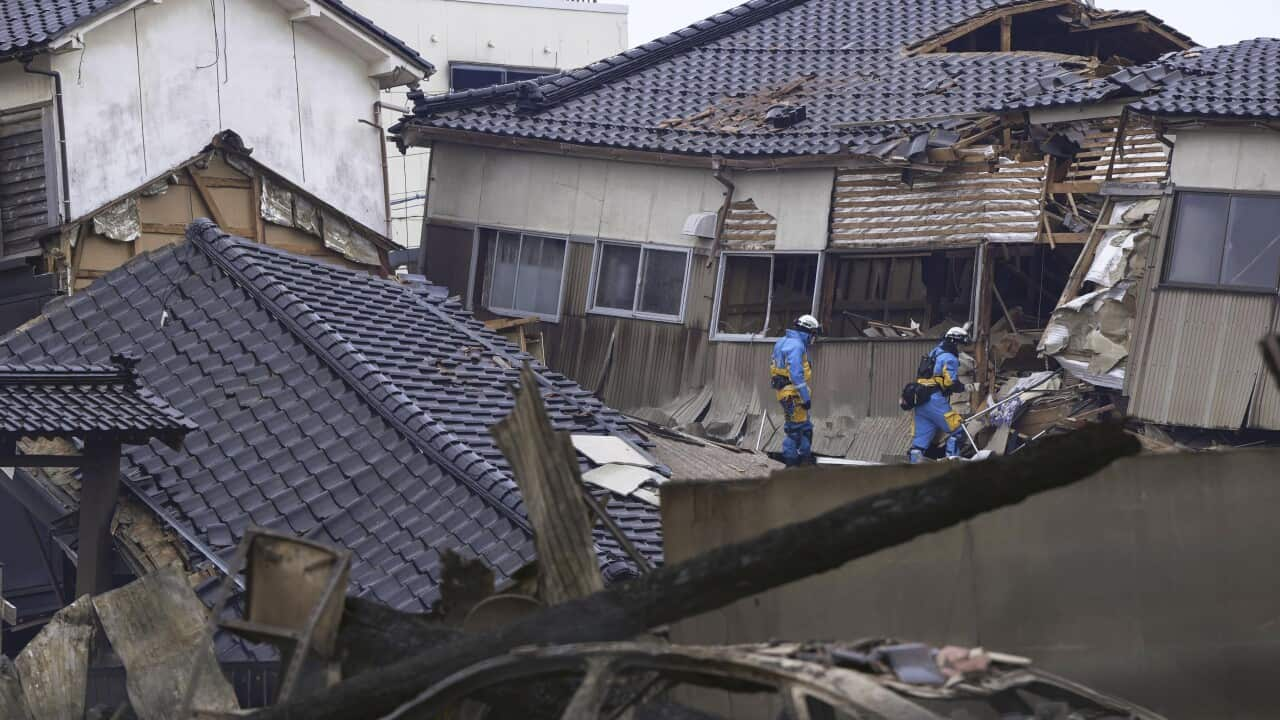Key Points
- A powerful 7.6-magnitude earthquake hit Japan on Monday.
- Major damage to roads, houses on west coast of main island.
- Thousands of rescuers struggling to reach worst-hit areas.
At least 48 people were killed after a powerful earthquake hit Japan on New Year's Day, with rescue teams struggling on Tuesday to reach isolated areas where buildings had been toppled, roads wrecked and power cut to tens of thousands of homes.
The quake with a preliminary magnitude of 7.6 struck on Monday afternoon, prompting residents in some coastal areas to flee to higher ground as tsunami waves hit Japan's west coast, sweeping some cars and houses into the sea.

Destroyed houses along the coast in Japan's Ishikawa prefecture on Tuesday. Source: AAP / AP
"The search and rescue of those impacted by the quake is a battle against time," Prime Minister Fumio Kishida said during an emergency meeting on Tuesday, donning a blue outfit commonly worn by officials during disaster relief operations.
Kishida said rescuers were finding it very difficult to access the northern tip of the Noto peninsula where helicopter surveys had discovered many fires and widespread damage to buildings and infrastructure.
Prime Minister Anthony Albanese expressed solidarity in a post on X, formerly Twitter.
"The thoughts of Australians are with the people of Japan at this difficult time. We are saddened to see the loss of life and destruction following yesterday’s earthquakes.
"As close friends, we stand ready to support Japan to provide any necessary assistance," he said.
Australian ambassador to Japan Justin Hayhurst also posted on X, saying: "Australia stands with our friends in Japan at this difficult time."
'Catastrophic' situation in affected areas
There are around 120 cases of people awaiting rescue, his government spokesperson later said. Many rail services and flights into the area have been suspended.
Noto's airport closed due to damage to its runway, terminal and access roads, with 500 people stranded inside vehicles in its parking lot, public broadcaster NHK reported.
In Suzu, a coastal town of just over 5,000 households near the quake's epicentre, there may have been up to 1,000 houses destroyed, according to its mayor Masuhiro Izumiya. "The situation is catastrophic," he said.
Authorities have confirmed 48 deaths so far, all in Ishikawa prefecture, NHK reported.

The quake triggered warnings for residents to evacuate some coastal areas. Credit: AP
"I've never experienced a quake that powerful," said Wajima resident Shoichi Kobayashi, 71, who was at home having a celebratory New Year's dinner with his wife and son when the quake struck.
"Even the aftershocks made it difficult to stand up straight," he said, adding his family slept in their car for fear of returning to the shaken home.
More than 140 tremors have been detected since the quake first hit on Monday, according to the Japan Meteorological Agency, which warned more strong shocks could hit in the coming days.

A shakemap shows the location of an earthquake hitting Ishikawa's Noto region on Monday. Source: AAP / USGS Handout/EPA
"I tried to hold the TV set to keep it from toppling over, but I could not even keep myself from swaying violently," Sugimori said from her home which had a large crack down its front wall and furniture scattered around the inside.
Across the street, a car was crushed under a collapsed building where residents had another close call. Fujiko Ueno, 73, said nearly 20 people were in her house for a New Year celebration when the quake struck but miraculously all emerged uninjured.
Nearly 100,000 people ordered to evacuate
"It all happened in the blink of an eye" she said, standing in the street amidst debris from the wreckage and mud that oozed out of the road's cracked surface.
Several world leaders sent condolence messages with President Joe Biden saying in a statement the United States was ready to provide any necessary help to Japan.
The Japanese government ordered around 100,000 people to evacuate their homes on Monday night, sending them to sports halls and school gymnasiums, commonly used as evacuation centres in emergencies.
Almost half of those evacuated had returned to their homes on Tuesday after authorities lifted tsunami warnings.

Japan has issued tsunami alerts after a series of strong earthquakes in the Sea of Japan on Monday. Source: AAP / Eugene Hoshiko/AP
The Imperial Household Agency said it would cancel Emperor Naruhito and Empress Masako's slated New Year appearance on Tuesday following the disaster.
Kishida postponed his New Year visit to the Ise Shrine scheduled for Thursday.
Japan's defence minister told reporters on Tuesday that 1,000 army personnel are currently involved in rescue efforts and that 10,000 could eventually be deployed.
Japan experiences hundreds of earthquakes every year and the vast majority cause no damage.
The country has strict regulations intended to ensure buildings can withstand strong quakes and routinely holds emergency drills.
But the country is haunted by the memory of a massive 9.0-magnitude undersea quake off northeastern Japan in March 2011, which triggered a tsunami that left around 20,000 people dead or missing.
The 2011 tsunami also sent three reactors into meltdown at the Fukushima nuclear plant, causing Japan's worst post-war disaster and the most serious nuclear accident since Chernobyl.
The Nuclear Regulation Authority said no abnormalities reported at the Shika atomic power plant in Ishikawa or at other plants after Monday's quake, which sparked a tsunami alert as far away as Russia's far east.










